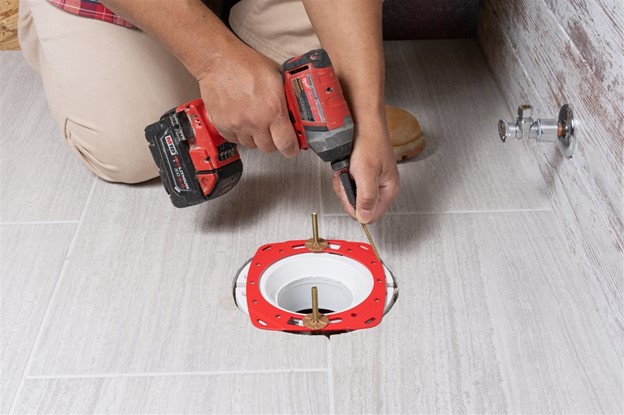5 easy DIY plumbing fixes you can tackle yourself

Dealing with anything plumbing related can sound intimidating, but there are minor repairs homeowners can easily do themselves. As long as you follow the instructions provided with products you’re using, you should be able to fix some common issues – and save a lot of money. Just remember, before tackling anything: Turn off the water to that area first.
Here are five common plumbing items you should be able to tackle on your own.
1. Swapping out a showerhead
If your showerhead is malfunctioning, or you just want an upgrade, this is a simple fix. A necessary product for this task – or to fix a leaky faucet – is thread sealant tape. This will help ensure you won’t have future leaks. Thread sealant tape is easy to use, and can come in several colors, widths, thicknesses and densities.
Wrap thread sealant tape clockwise several revolutions around to fully cover the threads. Clockwise is the same direction you will be screwing on the showerhead, so applying the tape the same direction prevents the new showerhead from catching the end of the tape and unraveling it.
2. Replacing a sink sprayer
Kitchen sink sprayers frequently wear out. If you’re unsure what type of sprayer you have, bring it (or a picture) to the store to be sure you purchase the correct replacement. If your sink sprayer is older, you may be able to replace just the sprayer without also swapping out the hose. Newer models typically come in one piece, while older ones may have a detachable hose. If the hose is torn or damaged, you may need to replace that as well.
Follow the instructions included with your new parts, and keep your thread sealant tape handy, as you will also need it to complete this project.
3. Fixing a running toilet
Contrary to what you may think, jiggling the handle will not fix your running toilet. If your toilet is running, it’s probably caused by a faulty floater valve or stop valve (also called a float cup or floater switch). That large bulb floating in the toilet tank prevents the continuous flow of fresh water into your toilet once the tank is filled, but if the valve is old and no longer prevents water from getting through, the tank will keep filling – hence the constant running, which is annoying and wastes water.
The best approach is simply to replace the entire toilet tank float valve assembly, which you can purchase at your local hardware or home improvement store. These come with complete instructions, and there’s no need to be nervous about using your hands in the tank, as the water there is clean.
4. Repairing a toilet flange
The toilet flange helps secure your toilet to the floor. If yours is damaged, you may see leaking near the toilet base or water pooling on the floor. You might also notice unpleasant smells, or your toilet could shift or rock (the entire toilet, not the seat).
Use a flange repair ring to fix broken, cracked or worn-out toilet mounting flanges, so you won’t have to replace the entire flange.
5. Unclogging drains
Before calling a plumber, try a plunger and/or snake. The quick fix for any clogged drain is a liquid drain cleaner, but certain chemical cleaners can damage some pipes if used incorrectly. However, some cleaners are beneficial if used properly. Make sure to choose the right one for the type of drain you’re trying to clean. For kitchen blockages, use a drain cleaner that removes fat and grease. For bathrooms, choose one formulated for soap scum and hair. Proactively using baking soda and vinegar can help prevent drains from clogging.
Courtesy of Brandpoint Content



